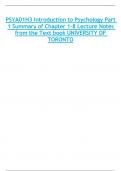Exam (elaborations)
PSYA01H3 Introduction to Psychology Part 1 Summary of Chapter 1-8 Lecture Notes from the Text book UNIVERSITY OF TORONTO
- Course
- Institution
PSYA01H3 Introduction to Psychology Part 1 Summary of Chapter 1-8 Lecture Notes from the Text book UNIVERSITY OF TORONTO
[Show more]



